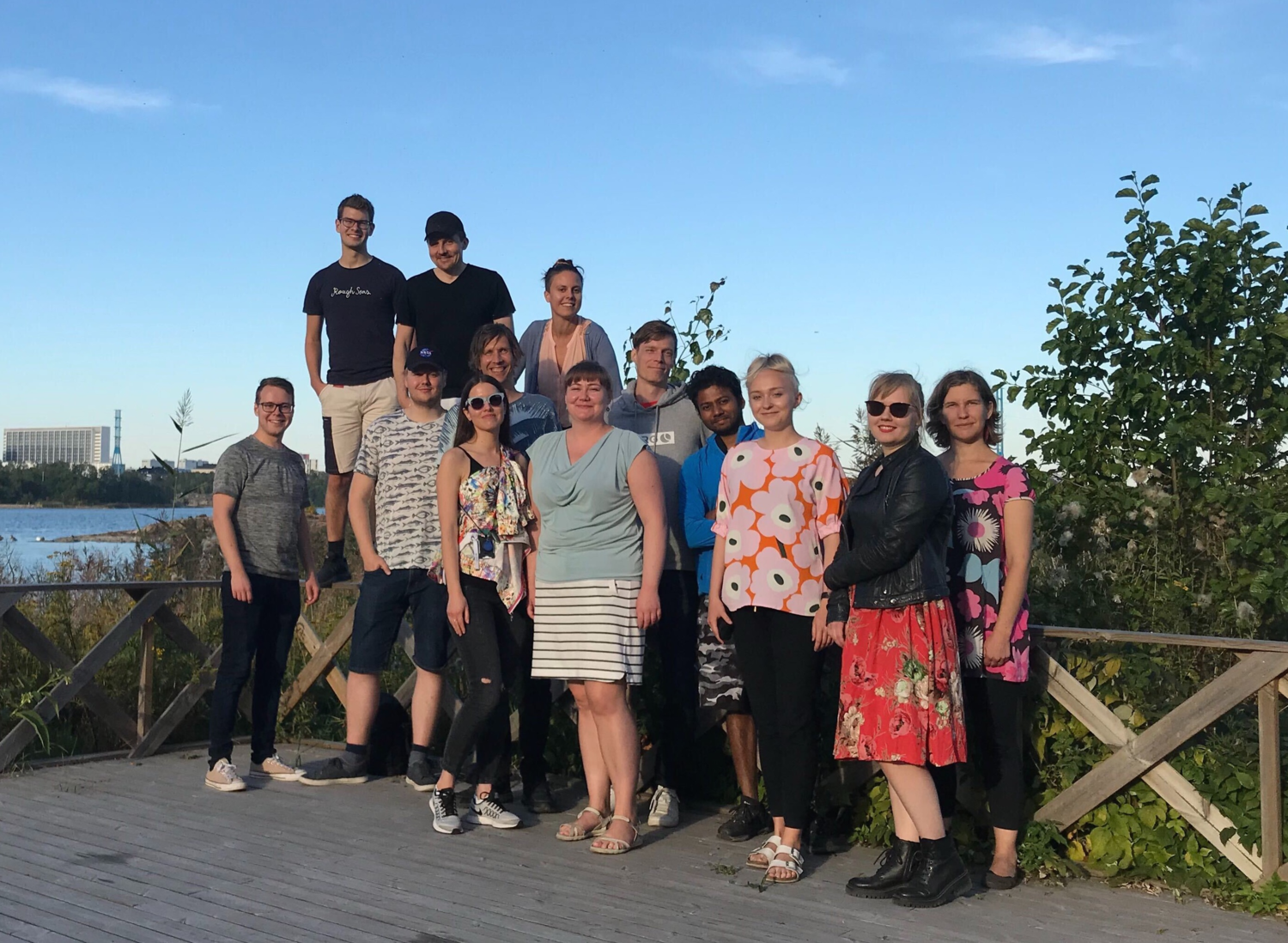Publications
Ala-Laurila, P. (2025). Visual pigments underlie the sensitivity difference between day
and night vision.
PNAS 122 (3).
[
PDF ]
Kilpeläinen, M., Westö, J., Tiihonen, J., Laihi, A., Takeshita, D., Rieke, F.,
Ala-Laurila, P. (2024).
Primate retina trades single-photon detection for high-fidelity contrast encoding.
Nature Communications 15:4501.
[
PDF |
PRESS RELEASE ]
Westö, J., Martyniuk, N., Koskela, S., Turunen, T., Pentikäinen, S. & Ala-Laurila,
P. (2022). Retinal OFF ganglion cells allow detection of quantal shadows at starlight.
Current Biology 32, 2848–2857.
[
PDF | COMMENTARY |
PRESS RELEASE - AALTO |
PRESS RELEASE - NEUROSCIENCE NEWS ]
Westö, J. & Ala-Laurila, P. (2020).
Seeing beyond violet: UV-cones guide high-resolution
prey-capture behavior in fish.
Neuron 107, 207–209.
[
PDF ]
Koskela, S., Turunen, T. & Ala-Laurila, P. (2020). Mice
reach higher visual sensitivity at night by using a more
efficient behavioral strategy. Current
Biology 30, 42–53.
[
PDF | COMMENTARY
|
FACULTY OF 1000 |
PRESS RELEASE ]
Smeds, L., Takeshita, D., Turunen, T., Tiihonen, J., Westö, J.,
Martyniuk, N., Seppänen A. & Ala-Laurila, P. (2019).
Paradoxical Rules of Spike Train Decoding Revealed at the
Sensitivity Limit of Vision. Neuron
104, 576–587.
[
PDF | COMMENTARY
|
PRESS RELEASE ]
Tikidji-Hamburyan, A., Reinhard, K., Storchi, R., Dietter, J.,
Seitter, H., Davis, K.E., Idrees, S., Mutter, M., Walmsley, L,
Bedford, R.A., Ueffing, M, Ala-Laurila, P., Brown,T.M., Lucas,
R.J. & Münch , T.A. (2017). Rods progressively escape
saturation to drive visual responses in daylight conditions. Nature Communications 8:1813.
[
PDF |
FACULTY OF 1000 ]
Takeshita, D., Smeds, L. & Ala-Laurila, P. (2017).
Processing of single-photon responses in the mammalian On and
Off retinal pathways at the sensitivity limit of vision. Phil.
Trans. R. Soc. B 372.
[
PDF ]
Ala-Laurila, P. (2016). Visual Neuroscience: How Do Moths See to
Fly at Night? Current Biology 26,
R229–R246.
[
PDF ]
Vartanian, G.V., Li, B.Y., Chervenak, A.P., Walch O.J., Pack W.,
Ala-Laurila, P. & Wong K.Y. (2015). Melatonin Suppression by
Light in Humans Is More Sensitive Than Previously Reported. J Biol
Rhythms 30, 351-354.
[
PDF ]
Ala-Laurila, P. & Rieke, F (2014). Coincidence Detection of
Single-Photon Responses in the Inner Retina at the Sensitivity
Limit of Vision. Current Biology
24, 2888-2898.
[
PDF |
COMMENTARY ]
Ala-Laurila, P., Greschner, M., Chichilnisky & Rieke, F
(2011). Cone photoreceptor contributions to noise and
correlations in the retinal output. Nature
Neuroscience 14, 1309-1316.
[
PDF ]
Luo, D. G., Yue, W.W., Ala-Laurila, P., & Yau, K.W. (2011).
Activation of visual pigments by light and heat. Science 332,
1307-1312.
[
PDF |
SUPP PDF |
COMMENTARY |
FACULTY OF 1000 ]
Ala-Laurila, P., Cornwall, M.C., Crouch, R.K., & Kono, M.
(2009). The action of 11-cisretinol on cone opsins and intact
cone photoreceptors. J Biol Chem
284, 16492-16500.
[
PDF ]
Estevez, M.E., Kolesnikov, A.V., Ala-Laurila, P., Crouch, R.K.,
Govardovskii, V.I., & Cornwall, M.C. (2009). The 9-methyl
group of retinal is essential for rapid Meta II decay and
phototransduction quenching in red cones. J
Gen Physiol 134, 137-150.
[
PDF ]
Ala-Laurila, P., Donner, K., Crouch, R.K., & Cornwall, M.C.
(2007). Chromophore Switch from 11-cis-dehydroretinal (A2) to
11-cis-retinal (A1) Decreases Dark Noise in Salamander Red Rods.
J Physiol 585, 57-74.
[
PDF ]
Cornwall M.C., & Ala-Laurila P. (2007). A perfect marriage:
molecular genetics ties the knot with electrophysiology in
studies of visual transduction. J
Gen Physiol 130, 7-10.
[
PDF ]
Jokela-Määttä, M., Smura, T., Aaltonen, A.,
Ala-Laurila, P., & Donner, K. (2006). Visual pigments of
Baltic Sea fishes of marine and limnic origin. Vis Neurosci 24,
389-398.
[
PDF ]
Ala-Laurila, P., Kolesnikov, A.V., Crouch, R.K., Tsina, E.,
Shukolyukov, S.A., Govardovskii, V.I., Koutalos, Y., Wiggert,
B., Estevez, M.E., & Cornwall, M.C. (2006). Visual cycle:
dependence of retinol production and removal on photoproduct
decay and cell morphology. J Gen
Physiol 128, 153-169.
[
PDF | JOURNAL COVER
|
COMMENTARY | HIGHLIGHTS FROM
LITERATURE | PAUL F. CRANEFIELD
AWARD
]
Kolesnikov, A.V., Ala-Laurila, P., Shukolyukov, S.A., Crouch,
R.K., Wiggert, B., Estevez, M.E., Govardovskii, V.I., &
Cornwall, M.C. (2006). Visual cycle and its metabolic support in
gecko photoreceptors. Vision Res
47, 363-374.
[
PDF ]
Estevez, M.E., Ala-Laurila, P., Crouch, R.K., & Cornwall,
M.C. (2006). Turning Cones Off: The Role of the 9-Methyl Group
of Retinal in Red Cones. J Gen
Physiol 128, 671-685.
[
PDF ]
Pahlberg, J., Lindström, M., Ala-Laurila, P.,
Fyhrquist-Vanni, N., Koskelainen, A., & Donner, K. (2005).
The photoactivation energy of the visual pigment in two
spectrally different populations of Mysis relicta (Crustacea,
Mysida). J Comp Physiol A
Neuroethol Sens Neural Behav Physiol 191, 837-844.
[
PDF ]
Ala-Laurila, P., Donner, K., & Koskelainen, A. (2004).
Thermal activation and photoactivation of visual pigments. Biophys
J 86, 3653-3662.
[
PDF ]
Ala-Laurila, P., Pahlberg, J., Koskelainen, A., & Donner, K.
(2004). On the relation between the photoactivation energy and
the absorbance spectrum of visual pigments. Vision Res 44,
2153-2158.
[
PDF ]
Tsina, E., Chen, C., Koutalos, Y., Ala-Laurila, P., Tsacopoulos,
M., Wiggert, B., Crouch, R.K., & Cornwall, M.C. (2004).
Physiological and microfluorometric studies of reduction and
clearance of retinal in bleached rod photoreceptors. J Gen Physiol
124, 429-443.
[
PDF ]
Ala-Laurila, P., Albert, R.-J., Saarinen, P., Koskelainen, A.,
& Donner, K. (2003). The thermal contribution to
photoactivation in A2 visual pigments studied by temperature
effects on spectral properties. Vis
Neurosci 20, 411-419.
[
PDF ]
Ala-Laurila, P., Saarinen, P., Albert, R., Koskelainen, A.,
& Donner, K. (2002). Temperature effects on spectral
properties of red and green rods in toad retina. Vis Neurosci 19,
781-792.
[
PDF ]
Koskelainen, A., Ala-Laurila, P., Fyhrquist, N., & Donner,
K. (2000): Measurement of thermal contribution to photoreceptor
sensitivity. Nature 403, 220-223.
[
PDF | COMMENTARY ]
Book Chapters
Seppänen, A. & Ala-Laurila, P. (2021). Silmä aivojen osana: älykäs verkkokalvo
pyydystää fotoneita ja ennustaa tulevaa.
Book chapter: Hari, R. & Carlson, S. (Eds.).
Aivoaakkoset. Helsinki: Aalto ARTS Books.
[
PDF ]
Kiani, R., Ala-Laurila, P. & Rieke, F. (2020). Seeing With a Few
Photons: Bridging Cellular and Circuit Mechanisms With
Perception. Book chapter: The Senses: A Comprehensive Reference 2nd
Edition, Elsevier, 2020.
https://doi.org/10.1016/B978-0-12-809324-5.24218-1.
[
PDF ]
Cookie policy
This document governs the cookie policy of our website
ala-laurila.biosci.helsinki.fi. We use cookies to provide,
customize, evaluate, improve and protect our Services. If you
have any comments or questions about this Cookie Policy, feel
free to contact us at
petri.ala-laurila@aalto.fi .
Our website uses cookies. A cookie is a small piece of data
or a text file that is downloaded to your computer or mobile
device when you access certain websites. Cookies may contain text
that can be read by the web server that delivered the cookie to
you. The text contained in the cookie generally consists of a
sequence of letters and numbers that uniquely identifies your
computer or mobile device; it may contain other information as
well.
By agreeing to accept our use of cookies, you are giving
us, and third parties we partner with, permission to place,
store, and access cookies on your computer.
We use cookies on the website and associated domains of
ala-laurila.biosci.helsinki.fi for the following purposes:
- Performance And Analytics. Cookies help us
analyze how the Services are being accessed and used, and enable
us to track performance of the Services. For example, we use
cookies to determine if you viewed a page. This helps us provide
you with information that you find interesting.
Google Analytics Privacy Notice
Our website uses
Google Analytics to collect information about the use of our
website. Google Analytics collects information from users such as
age, gender, interests, demographics, how often they visit our
website, what pages they visit, and what other websites they have
used before coming to our website. We analyse this data using
tools such as Google Analytics. For more information on Google
Analytics, visit
http://www.google.com/analytics/ . You can
prevent Google Analytics from collecting data by downloading an
browser add-on at:
https://tools.google.com/dlpage/gaoptout .





















